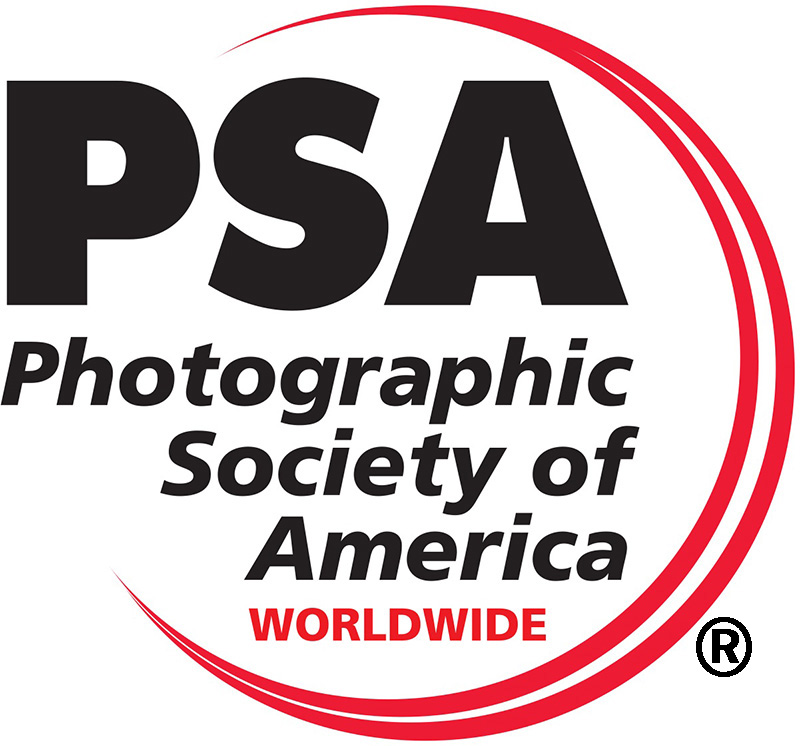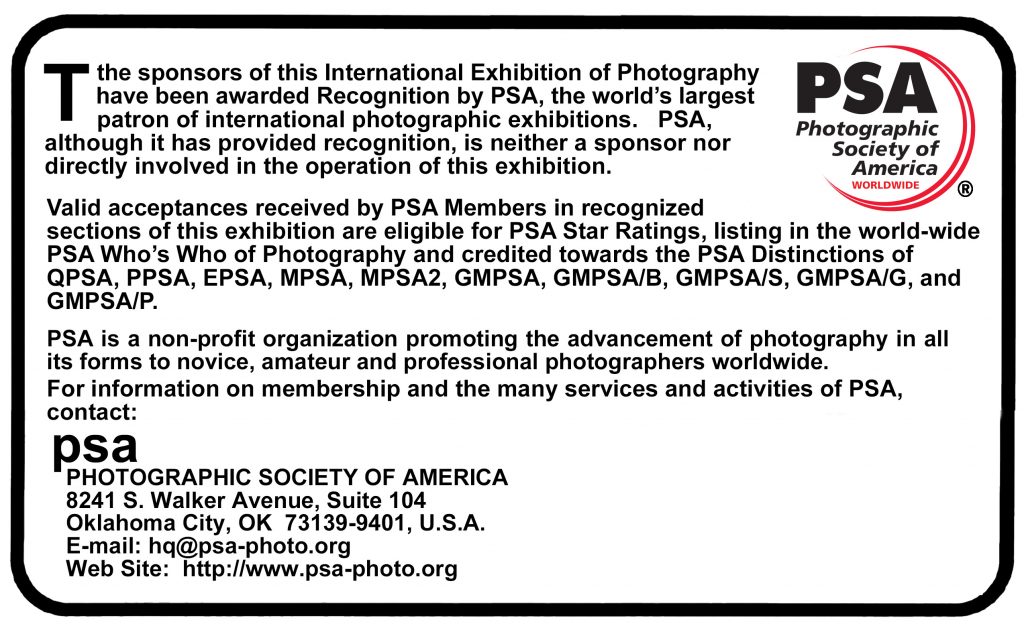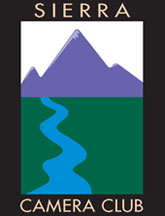North American International Exhibition 2021
Chairman: Jan Lightfoot
6672 Dusty Trails
Vacaville, CA 95688
email: lightfoot1405@gmail.com
Digital Chairman: Cheryl Glackin
email: cg1naie@gmail.com
Digital Chairman: Kristian Leide-Lynch
email: kllnaie@outlook.com
Recognition Number: PSA 2021-1477

CALENDAR:
Closing date: September 4, 2021
Judging: September 11-12, 2021
Notifications emailed: September 25, 2021
Mailing of Awards: November 27, 2021
Catalog Availability Date: November 27, 2021 (online)
ENTRY FEES:
The Entry Fees are $8 US Dollars per section. Entry fees are the same worldwide. Entry Fees must be paid via PayPal in US Dollars, no exceptions. Any entry not paid by the closing date will not be judged or included in the list sent to Star Ratings, Who's Who, etc.
Entries will be judged randomly in four rounds.
JUDGES:
Color, Monochrome, Photojournalism
Sam Shaw, FPSA, MPSA, Turlock, CA
Truman Holtzclaw, APSA, Lincoln, CA
Don Goldman, Roseville, CA
Nature and Wildlife
Loye Stone, PPSA, Fresno, CA
Melanie Lewert, Milpitas, CA
David Rosen, Woodland, CA
PROJECTED IMAGE MEDALS:
In each section, Color Open / Monochrome /Photojournalism/ Nature / Wildlife
the awards are as follows:
PSA Gold - Best of Show
PSA Silver - 2nd Place
PSA Bronze - 3rd Place
Six Honorable Mentions
Judge’s Choice Awards (3)
Digital Chairman’s Awards (2)
Chairman’s Award (1)
CATALOG:
The catalog of the Exhibition will be available only in the form of a PDF download from the Exhibition website. A link to accepted images, including award winners, will be on display at www.northamericaninternationalexhibition.com Public exhibitions will also be shown after the judging.
READ CAREFULLY BEFORE ENTERING!
ENTRY RULES / APPLIES TO ALL DIVISIONS AND SECTIONS
Participation: This Exhibition will be conducted according to the recommended practices of the Photographic Society of America (PSA). The exhibition is open to anyone; however, an entry may be rejected when the sponsoring organization or its agent, in its reasonable discretion, believes the entry does not conform to the exhibition rules and conditions. Membership in any photographic organization is not required.
Sanctions: Entries will not be accepted from any entrant who is currently sanctioned by PSA.
An entrant's images will not be presented to the judges consecutively. An entrant’s four images will be distributed throughout four rounds of judging in that section. Distribution of images shall be in the same round order as submitted by the entrant.
Entries must originate as photographs (image captures of objects via light sensitivity) made by the entrant on photographic emulsion or acquired digitally. By virtue of submitting an entry, the entrant certifies the work as his own (aliases are not permitted). Images may not incorporate elements produced by anyone else. The entrant permits the sponsors to reproduce all or part of the entered material free of charge for publication and/or display in media related to the exhibition. This may include low resolution posting on a website. Note: Entrants who indicate that their images may not be reproduced or used "will not be eligible for awards" or inclusion in audio-visuals of the exhibition "and could be subject to disqualification" by the exhibition sponsors. The Sponsor or its agent assumes no liability of any misuse of copyright by anyone.
Images may be altered, either electronically or otherwise, by the maker. Artwork or computer graphics created by the entrant may be incorporated provided the photographic content predominates, subject to Nature divisional restrictions. All final work must be on electronic file.
Titles will not be read at judging. Titles must be 35 characters or fewer. No titles may be visible to the judges on the projected digital image, and nothing in the digital image may identify the maker.
Each image must have a unique title. Once an image has been accepted in a PSA Recognized Exhibition, that same image, or a like “in camera” or a “reproduction” duplicate of that image:
A. May not be re-entered in any section of the same Division Star Ratings class in that exhibition regardless of media, format, or title.
B. May not be re-titled for entry in any other PSA Recognized Exhibition.
C. Images meeting the Monochrome Definition and non-manipulated color images from the same capture shall be considered the same image and must be given the same title.
D. PSA members working on Galaxy and Diamond Star ratings shall be allowed to continue using different titles of monochrome versions and color versions of the same capture that have already been accepted until the required number of acceptances for those titles have been completed.
Titles may not include file extensions such as .jpg or .jpeg, nor are camera capture file names or words such as “untitled” or “no title”; neither can titles consist solely of numbers.
To receive proper Star Ratings credit from PSA, entrants must provide their name and country exactly the same in each exhibition. Aliases are not permitted. Please contact PSA in the event of name changes or relocating to another country.
An image may be entered in only one section where acceptances of that image in multiple sections would be eligible for the same star path.
ACCEPTANCES:
The target range for acceptances will be between 28% and 34%.
BREACH OF ENTRY RULES:
If the exhibition determines before, during, or after the judging that an entrant has submitted entries where one or more images fail to comply with these Conditions of Entry, including the stated definitions, the exhibition reserves the right and discretion to delete the entry from the exhibition and void any or all acceptances or awards. Fees may be forfeited in these circumstances. The entrant acknowledges that the decision of the exhibition organizers or the judges is final.
In order to ensure that images comply with the Conditions of Entry and definitions, the exhibition may carry out checks on the images to make sure that:
a. the images are the original work of the entrant and
b. the images comply with the rules and definitions as set out in these Conditions of Entry.
These steps include, but are not limited to, questioning any entrant, requiring the submission of RAW files or other digital files representing the original capture of the submitted images(s), confronting the entrant with evidence that one or more submitted images fails to comply with the Conditions of Entry (also know as Entry Rules), and offering the entrant a reasonable opportunity to provide counter evidence to refute the exhibition organizer's evidence by a set deadline. Such entries that are not cleared or are still questionable after the entrant has presented evidence may be considered in breach of these Conditions of Entry, and declined. Such entries may be referred to PSA for further investigation of possible ethics violations.
PSA retains the right to investigate in any way all complaints/suspicions of breaches of entry conditions, impose sanctions if deemed necessary, void the acceptances of any image found to violate the PSA rules, include the entrant's name on the list of sanctions provided to Exhibitions, and share such investigations with FIAP. Entrants automatically agree to these terms by the act of entering the Exhibition.
If another party is submitting images on the entrants behalf, the entrant will still be held responsible for adhering to these Conditions of Entry (Entry Rules) and will be subject to sanction for any violations to these Conditions of Entry and PSA's Statement of Ethics that may result.
SUBMITTING ENTRIES:
An Entry consists of up to and including four (4) images per Section entered by a single Entrant into the same Section. The four or fewer digital images in a Section will be distributed throughout four rounds of judging for that Section. An image can only be entered once in the same North American International Exhibition.
DATA PROTECTION:
By entering this exhibition, you are explicitly consenting to the personal details you have supplied, including email addresses, being held, processed and used by the exhibition organizers for purposes associated with this exhibition. You also explicitly consent to such information being sent to organizations that have accorded official recognition, patronage or accreditation to this exhibition. You acknowledge and accept that entering this exhibition means that the status and results of your entry may be made public.
NOTICE: When an entrant fills in the Entry Form to submit an entry, the entrant will see a feature to affirm he or she has read these Conditions of Entry when he or she fills out the entry form. If the entrant does not so affirm, the entry not be submitted.
IMPORTANT: Digital images must be in JPEG format. Image width must not exceed 1920 pixels and height must not exceed 1080 pixels. Images larger than the permitted size will be rejected along with a request to re-submit a correctly sized image.
Digital entries must be entered online using the online entry process here. CD’s and email attachments are NOT permitted.
Digital images will be displayed for remote judging using individual monitors and laptops with native resolutions of 1920 pixels x 1080 pixels. The images will be displayed by each remote judge at the actual pixel submitted. Use the maximum quality for each of your jpeg images that does not result in a file size larger than 2mb.
Projected Image Divisions and Definitions
PSA Statement on Subject Matter - There is one hard and fast rule, whose spirit must be observed at all times and applies to all sections offered in PSA recognized exhibitions. The welfare of the subject is more important that the photograph. This means that practices such as baiting of subjects with a living creature and removal of birds from nests, for the purpose of obtaining a photograph, are highly unethical, and such photographs are not allowed in any PSA exhibitions. Judges are warned not to reward them.
There is also a PSA policy on the use of aerial photography - aircraft, helicopters and drones. This policy can be found at https://psa-photo.org/index.pho?psapolicies#drone. The purpose of this policy is to prevent any interference with other individuals or animals which will or may cause a disturbance in their normal activity or disrupt the way any individuals or animals interact with their environment. Entry in this exhibition requires exhibitors to agree to this and other PSA policies. The content of images must comply with these General Conditions and with the Division and Section Definitions listed in these conditions. Images that - in the sole opinion of the judges or the Exhibition Organizers - do not comply are likely to be disqualified so the entrant may be aware of the problem when considering entry into other PSA recognized exhibitions.
Submission of an entry signifies acceptance of all of our conditions.
The decision of the jury will be final and without appeal.
PROJECTED IMAGE DIVISION: COLOR
There is one Section, Color Open.
Section 1: Color Open/ Any image that satisfies the general rules may be submitted in the Open Section. Monochrome images may NOT be entered into this Color Open Section. However, spot color images with a grayscale background may be entered. Evaluation will be based primarily on pictorial and technical content. Any subject or theme is eligible.
PROJECTED IMAGE DIVISION: MONOCHROME
There is only one section in Monochrome:
Section 1: Monochrome/ An image is considered to be Monochrome only if it gives the impression of having no color (i.e. contains only shades of gray which can include pure black or pure white) OR it gives the impression of being a grayscale image that has been toned in one color across the entire image (for example, by Sepia, red, gold, etc.). A grayscale or multicolored image modified or giving the impression of having been modified by partial toning, multitoning or by the inclusion of spot coloring does not meet the definition of monochrome and shall be classified as a Color Work. Borders in monochrome, if any, must be colored the same as the overall image, that is, in shades of gray for a grayscale image; or toned in the same color as the rest of the image for a toned image. Monochrome images are judged both for their technical and pictorial merit. The content will be based primarily on pictorial and technical content. Any subject or theme is eligible. Monochrome images may not be entered in PID Color sections.
PROJECTED IMAGE DIVISION: Photojournalism
There is only one section in Photojournalism: / Photojournalism entries are images with informative content and emotional impact, reflecting the human presence in our world. The journalistic (story-telling) value of the image should receive priority over pictorial quality. Images that misrepresent the truth, such as those from events or activities arranged specifically for photography, or of subjects directed or hired for photography are not eligible.
Techniques that add, relocate, replace, remove, or change any element in the original scene, except by cropping, are not permitted. All images must look natural. The only allowable modifications are removal of dust, scratches or digital noise and restoration of the appearance of the existing scene, or complete conversion to greyscale monochrome. Other derivations, including infrared, are not eligible.
Attention is drawn to the PSA Statement on Subject Matter which applies to all sections.
NATURE DIVISION
There are two sections, Nature and Wildlife. Only Wildlife photographs may be entered in the Wildlife Section. Wildlife photos may also be entered in the Nature Section.
Section 1: Nature/ Nature photography is restricted to the use of the photographic process to depict all branches of natural history, except anthropology and archaeology, in such a fashion that a wellinformed person will be able to identify the subject material and certify its honest presentation. See Definition of Nature Photography for full Nature and Wildlife definitions.
The story telling value of a photograph must be weighed more than the pictorial quality while maintaining high technical quality. Human elements shall not be present, except where those human elements are integral parts of the nature story such as nature subjects, like barn owls or storks, adapted to an environment modified by humans, or where those human elements are in situations depicting natural forces, like hurricanes or tidal waves.Scientific bands, scientific tags or radio collars on wild animals are permissible.Photographs of human created hybrid plants, cultivated plants, feral animals, domestic animals, or mounted specimens are ineligible, as is any form of manipulation that alters the truth of the photographic statement.No techniques that add, relocate, replace, or remove pictorial elements except by cropping are permitted.Techniques that enhance the presentation of the photograph without changing the nature story or the pictorial content, or without altering the content of the original scene, are permitted including HDR, focus stacking and dodging/burning.Techniques that remove elements added by the camera, such as dust spots, digital noise, and film scratches, are allowed. Stitched images are not permitted.All allowed adjustments must appear natural. Color images can be converted to gray-scale monochrome.Infrared images, either direct captures or derivations, are not allowed.
Images in the Nature sections meeting the Nature Photography Definition above can have landscapes, geologic formations, weather phenomena, and extant organisms as the primary subject matter. This includes images taken with the subjects in controlled conditions, such as zoos, game farms, enclosures that make the subjects dependent on man for food, and botanical gardens.
Attention is drawn to the PSA Statement on Subject Matter which applies to all sections.
Section 2: Wildlife/ (PSA Authentic Wildlife Definition) Images entered in Wildlife sections meeting the Nature Photography Definition above are further defined as one or more extant (that is, still in existence) zoological or botanical organisms free and unrestrained in a natural or adopted habitat. See Definitions of Nature Photography for full Nature and Wildlife definitions.
A. Landscapes, geologic formations, photographs of zoo or game animals, or of any extant zoological or botanical species taken under controlled conditions are NOT eligible in Wildlife sections.
B. Wildlife is not limited to animals, birds and insects. Marine subjects and botanical subjects (including fungi and algae) taken in the wild are suitable wildlife subjects, as are the carcasses of extant species.
Attention is drawn to the PSA Statement on Subject Matter which applies to all sections.

